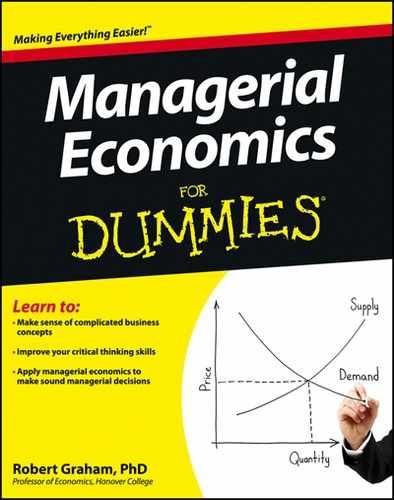Chapter 5
Consumer Behavior: A Market for Anything?
In This Chapter
![]() Understanding what makes your customers happy
Understanding what makes your customers happy
![]() Taking advantage of indifference
Taking advantage of indifference
![]() Developing promotions to influence consumer choice
Developing promotions to influence consumer choice
Successful businesses satisfy consumer desires. Knowing how consumers decide which desires to satisfy and which to leave unsatisfied is an important component in your managerial decision-making. Consumer theory describes how customers determine the purchases they make. By understanding consumer theory, you can influence customer behavior through pricing strategies such as coupons and gift cards.
Satisfying the Consumer
A famous line from the movie Field of Dreams is “If you build it, he will come.” Well, that may have worked in the movie, but it doesn’t work for businesses — “produce it and they will buy” isn’t a certainty. Consumers compare the amount of satisfaction they receive from a good to its price to determin Take the partial derivative of the Lagrangian function with respecte whether or not it’s worth buying. Remember, ultimately the customer decides whether or not your product is a good deal.
Comparing apples and oranges: Utility as a common denominator
You’ve probably heard the expression “You can’t compare apples and oranges.” It’s an absurd expression because of course you can compare apples and oranges, and you probably have. If you ever thought, “Oranges are really expensive this week; maybe I should buy apples instead,” you just compared them. And the produce section manager also compares them all the time. At the very least, the manager has to decide how much space to allocate to displaying oranges and apples. And I suspect that the manager allocates more space to the one that makes the store more money.
It’s crucial for you to recognize that consumers are always comparing different goods. Consumers must decide how much they’re going to buy of each good — how many apples, how many oranges, how many tickets to the baseball game, how many new bicycles . . . the list is never ending.
How much you like apples, oranges, or any other good is based upon the amount of pleasure or satisfaction you get from the good. But instead of using terms like pleasure or satisfaction, economists use the term utility.
You don’t have to measure everything as precisely as this example indicates. However, using utils makes consumer theory easier to understand.
Adding happiness — at a price
Typically, as you consume a greater quantity of a good, you get more satisfaction. You get satisfaction from the first scoop of ice cream you eat, and you get additional satisfaction from eating a second scoop of ice cream.
Economists also compare your additional satisfaction to the good’s price.
![]()
This equation indicates the amount of additional satisfaction you receive when you consume an additional dollar’s worth of the good.
Getting less from more: The law of diminishing marginal utility
So, you really like ice cream. A one-scoop ice cream cone is good, and a two-scoop ice cream cone is better. Because you get additional satisfaction or utility from the second scoop of ice cream, your marginal utility is positive and your total utility increases. If you add a third scoop of ice cream, your total utility may continue to increase, but it’s not likely to increase as much as with the second additional scoop. The third scoop of ice cream tastes good, but you also start to get full, and it starts to melt and make a mess. As a result, your additional satisfaction — your marginal utility — for the third scoop of ice cream is less than for the second scoop. Your marginal utility has begun to decrease. But although your marginal utility — additional satisfaction — has decreased, your total utility is still increasing.
Using utils in the ice cream example can illustrate this idea. Eating a one-scoop ice cream gives you 60 utils of satisfaction. Because this is the first scoop, the total utility and marginal utility are both 60. But one scoop is not quite enough; it leaves you wanting more. Adding a second scoop to your ice cream cone increases your total utility from 60 to 150. Therefore, the marginal utility or additional satisfaction of the second scoop is 90 utils — 150 – 60. To add a third scoop of ice cream increases your total utility to 200 utils. The third scoop tastes good, but it causes a mess. The change in total utility for the third scoop or the marginal utility of the third scoop is 50 — 200 – 150. Thus, the marginal utility of the third scoop, 50, is less than the marginal utility of the second scoop, 90, but the total utlity of the third scoop has increased from 150 to 200.
What happens in the ice cream situation happens with all goods. The first few units you consume tend to give you a lot of satisfaction, but eventually you reach a point where an additional unit gives less additional satisfaction.
The first slice of pizza tastes great and you get 20 utils of satisfaction. The second slice tastes even better and you get 30 additional utils of satisfaction. Your total utility is now 50 utils (20 + 30). The third slice of pizza also tastes good, but not quite as good as the second — your additional satisfaction is only 25 utils. At this point, diminishing marginal utility has set in, because 25 is less than 30. However, note that your total utility is still increasing. It is now 75 utils (20 + 30 + 25).
Diminishing marginal utility continues and by the time you reach the eighth slice of pizza, you’re stuffed. The pizza still tastes good, but your stomach is starting to hurt from all the pizza. At this point, marginal utility becomes negative, and your total utility starts to decrease.
Table 5-1 illustrates this situation.

Doing the Best You Can Given Consumer Constraints
Although you like both apples and oranges, you can’t eat as many as you want because you’re constrained by your income and the price of apples and oranges. The constraint imposed by income and the price of goods is called the budget constraint. The budget constraint is an equation that indicates that if you multiply the quantity of each good purchased by its price and then add those numbers up for all goods, the result must equal your income. Thus, the budget constraint would look like this for apples and oranges
![]()
In this equation, I is your income, pa is the price of an apple, qa is the quantity of apples purchased, po is the price of an orange, and qo is the quantity of oranges purchased.
![]()
![]()
One possible combination of apples and oranges you can purchase with the $6.00 are 2 apples, requiring $1.50 ($0.75×2), and 9 oranges requiring $4.50 ($0.50 ×9). Other possible combinations of apples and oranges you can purchase include 0 apples and 12 oranges, 4 apples and 6 oranges, 6 apples and 3 oranges, or 8 apples and 0 oranges.
Maximizing Pleasure through Consumer Choice and Constrained Optimization
Choosing among the incredible number of goods available to you isn’t difficult. Indeed, you do it all the time. You make these decisions based upon what gives you more happiness. You’ve maximized your happiness if you’re indifferent to or less satisfied with any other combination of goods as compared to what you already have.
Identifying indifference
I don’t care. You’ve probably said that phrase yourself. When I’m asked whether I want an apple or an orange, and I say “I don’t care,” it means I’m indifferent.
If I’m asked whether I’d like 3 apples and 8 oranges, or 4 apples and 6 oranges, or 5 apples and 5 oranges, and I say “I don’t care,” I’ve indicated indifference among all three of those possibilities. Each of those combinations gives me the same total utility.
Economists graph this situation with — are you ready — an indifference curve! An indifference curve shows all possible combinations of two goods that result in the same level of total utility. Figure 5-1 graphs my indifference curve for apples and oranges. This curve is labeled U1.
Again, every point on the indifference curve U1 gives me the same level of satisfaction or utility. But as was the case with ice cream earlier in this chapter, as I eat more apples, I experience diminishing marginal utility. The result of diminishing marginal utility is I become less willing to give up oranges for an additional apple. When I start with 3 apples, I’m willing to give up 2 oranges — going from 8 to 6 oranges — in order to get one more apple, or, in the example, to get a fourth apple. In Figure 5-1, I’m moving from point A to point B on the indifference curve. Once I have 4 apples, I’m only willing to give up 1 orange to get another apple, going from 4 to 5 apples. This is represented by moving from point B to point C in Figure 5-1. I’m not as willing to give up oranges for apples because an additional apple doesn’t give me as much marginal utility. As a result of diminishing marginal utility, indifference curves are drawn convex to the origin on a graph. Convex to the origin is just a fancy term for the bowed shape the indifference curve has in Figure 5-1.
It’s possible for me to get more satisfaction. If I get 6 apples and 6 oranges, that’s better than my combination of 5 apples and 5 oranges because I’m getting both an extra apple and an extra orange. I get more utility from 6 apples and 6 oranges than I get from 5 apples and 5 oranges. Because 5 apples and 5 oranges are on my original indifference curve U1,, this new combination of apples and oranges will be on a new indifference curve — an indifference curve with higher utility or satisfaction. Thus, I move from point C on indifference curve U1 to point D on indifference curve U2 in Figure 5-2.
Indeed, I have lots of different indifference curves representing various levels of satisfaction. These indifference curves are illustrated on an indifference curve map like the one in Figure 5-2. As already mentioned, the indifference curve U2 represents combinations of apples and oranges that give me more utility than combinations on indifference curve U1. On the other hand, the indifference curve U0 illustrates combinations of apples and oranges that give me less utlity than the combinations on indifference curve U1.

Figure 5-1: Indifference curve for apples and oranges.

Figure 5-2: Indifference curve map for apples and oranges.
Thinking at the margin: Just one more
As I tell you earlier in this chapter (see the earlier section “Adding happiness — at a price”), marginal utility is the change in total utility that occurs when one additional unit of a good is consumed. When you have an indifference curve, the amount of utility that you gain from eating one more orange is exactly offset by the amount of utility you lose by consuming fewer apples. This doesn’t mean you consume one less apple when you consume one more orange (as indicated in Figure 5-1). To remain on the same indifference curve, you keep eating fewer apples until the marginal utility you lose from eating fewer apples is exactly offset by the marginal utility you gain from eating one more orange.
Knowing the marginal rate of substitution
![]()
Consuming within limits
Now, add the budget constraint to the diagram. Remember, you can only purchase combinations of goods on the budget constraint.
In the earlier section “Doing the Best You Can Given Consumer Constraints,” I give an equation for my budget constraint in purchasing apples and oranges
![]()
Adding this budget constraint to the indifference curve map graphed in Figure 5-2 generates the diagram in Figure 5-3.

Figure 5-3: Optimal combination of apples and oranges.
Deciding what makes you happiest
Consumers want to get as much happiness as possible.
Now for some magic. At the point where you’re happiest given your budget constraint, the indifference curve and budget constraint are tangent with one another. This means the slopes of these two curves are equal. Therefore
Or, if you rearrange that equation
![]()
The preceding equation is an application of what economists call the equimarginal principle. By equating — “equi” — the marginal utilities per dollar spent (marginal) for all goods, you receive the maximum satisfaction or utility given your budget constraint.
Choosing to Use Calculus with Consumer Choice
Measuring indifference
Indifference curves can be described by functions. For example
![]()
shows the relationship between the quantity consumed of good x, the quantity consumed of good y, and total utility.
Constraining factors
Again, consumers face a budget constraint. For example, a consumer has a weekly budget of $400 for goods x and y. The price of good x is $10 and the price of good y is $8. The budget constraint is
![]()
where x and y are the quantities consumed of each good.
Lagrangians can make you happy
You’ll recognize this as a constrained optimization problem — the consumer is trying to maximize utility, subject to a budget constraint. This situation is ideal for a Lagrangian. (Go to Chapter 3 for more information on the Lagrangian function and how to set it up.)
1. Create a Lagrangian function. Recognize that the variable you’re trying to maximize is total utility. So, your objective function is 8x0.5y0.5. Second, your constraint is represented by the budget 400 – 10x – 8y = 0. Your Lagrangian function £ is
![]()
2. Take the partial derivative of the Lagrangian with respect to x and y, the commodities you’re consuming, and set them equal to zero. These equations ensure that total utility is being maximized.
![]()
![]()
3. Take the partial derivative of the Lagrangian function with respect to λ and set it equal to zero. This partial derivative ensures that the budget constraint is satisfied.
![]()
Solving the three partial derivatives simultaneously for the variables x, y, and λ maximizes total utility, subject to the budget constraint.
Rewriting the partial derivative of £ with respect to x enables you to solve for λ.
![]()
Substituting the above equation for λ in the partial derivative of £ with respect to y yields
![]()
So
![]()
Finally, substituting 0.8y for x in the constraint (the partial derivative of £ with respect to λ) yields
![]()
Thus, you should consume 25 units of good y.
Earlier you determined x = 0.8y.
![]()
Finally, you can solve for λ.
![]()
Therefore, the combination 20 units of good x and 25 units of good y maximizes total utility given the budget constraint.
In addition, λ equals 0.447. Lambda is an awesome shortcut. Most decisions are affected by constraints, but constraints are not necessarily absolute. Often times, a constraint can be varied a little bit. Lambda, the Lagrangian multiplier, shows you the impact changing the constraint has on the objective function. Specifically, if you change the constraint one unit, lambda indicates how much the variable you’re optimizing will change. Thus, in the example, if your income increases by $1 (you change the constraint by one unit) your total utility increases by 0.447 utils.
I graph this example in Figure 5-4.

Figure 5-4: Optimal combination of goods x and y.
Influencing Consumer Choice
Understanding consumer behavior helps you in determining how to influence it. After all, your goal is to maximize profits, but to do that, you have to have customers purchase your product. The previous sections in this chapter illustrate a crucial point — consumers make decisions based upon satisfaction/utility and price. And although you can influence satisfaction through things like advertising, you have complete control over price. Thus, how you price your product influences how much customers purchase, because changing the good’s price changes the customer’s budget constraint.
Buying one to get one free
One common pricing strategy is to offer customers who buy one unit of your product a second unit free. You may wonder how this strategy makes sense — if customers have already decided to buy one unit, why should you give them a second unit for free? But the point is that you don’t know whether customers will buy one unit. The purpose of this pricing strategy is to get more customers to purchase the first unit.


Figure 5-5: Utility maximizing number of tacos and pizza slices.
The customer’s goal is to maximize utility by going to the highest indifference curve touched by the budget constraint Ba. For the indifference curve map in Figure 5-5, the highest indifference curve touched by the budget constraint Ba is Ua, which indicates the customer buys six tacos and zero slices of pizza.
Now, you decide to offer a special promotion: buy one slice of pizza and your second slice is free. Now, if customers buy one slice of pizza, they can still buy four tacos. And because the second slice of pizza is free, the customers can still buy four tacos with two slices of pizza. The resulting budget constraint is described in the last two columns of Table 5-2.
On the graph, this promotion has added a horizontal section to the budget constraint, shifting the budget constraint out at the point between one and two slices of pizza. (Remember, the second slice of pizza doesn’t cost customers anything.) The new budget constraint for the customer is Bb in Figure 5-6.
Again, your customers want to maximize utility by finding the highest indifference curve touched by the new budget constraint. This is the indifference curve Ub in Figure 5-6 and it indicates that the customers now buy four tacos and two slices of pizza. You’ve gone from selling no pizza to this customer to selling two slices! And as an added bonus, your customer is getting even more satisfaction than before.

Figure 5-6: Utility maximizing number of tacos and pizza slices for the buy one, get one free promotion.
Selling gift cards
Gift cards are used to bias customers toward your business over a competitor. Because the customer can use the gift card at only your business, gift cards affect the shape of the budget constraint.
Figure 5-7 compares the two budget constraints. The budget constraint Ba is the budget constraint that exists if the customer can spend $50 cash at either your store or a competitor’s store. (I assume a price of $1 per unit for the good being purchased.) Given $50 cash, the customer maximizes utility on indifference curve Ua, spending $38 at your competitor’s store and $12 at your store.
If the customer has a $25 gift certificate at your store, the maximum he can spend at the competitor’s store is $25, while he can spend a maximum of $50 at your store ($25 cash plus $25 gift certificate). The new budget constraint is Bb. Now the customer maximizes utility with indifference curve Ub, spending $25 at your competitor’s store and $25 at your store. That’s $13 more than he had previously spent at your store!

Figure 5-7: Examining the benefit of gift cards.
Issuing coupons
As with gift cards, businesses use coupons to bias customers toward buying a particular good or from a specific business. By giving customers a discount, you effectively lower the product’s price. An added advantage of coupons is that they allow you to differentiate between consumers with different price elasticities of demand — more on that in Chapter 13.
Before the coupon, your customers were deciding between tacos priced at $0.50 each and pizza priced at $1.00 per slice. The customer had $3.00 to spend. The budget constraint for this situation is described by Ba in Figure 5-8. In this situation, the customer maximizes utility by purchasing four tacos and one slice of pizza — the point where the indifference curve Ua is tangent to the budget constraint Ba.
If you now offer $0.25 off per slice of pizza, the effective price is $0.75 per slice. Now the customer can buy up to four slices of pizza. The new budget constraint is Bb in Figure 5-8. The pivot in the budget constraint reflects the lower after-coupon price of a pizza slice. As a result, the customer now purchases three tacos and two slices of pizza — the point where the indifference curve Ub is tangent to the new budget constraint Bb.

Figure 5-8: Coupons attract customers.
As these examples indicate, understanding consumer theory gives you multiple options on pricing strategies that increase your sales.


 Economists like to measure everything — even satisfaction. They measure satisfaction using the idea of utils. Thus, an apple might give me 12 utils of satisfaction while an orange gives me 24 utils of satisfaction. Comparing the utils shows that I like the orange twice as much as the apple.
Economists like to measure everything — even satisfaction. They measure satisfaction using the idea of utils. Thus, an apple might give me 12 utils of satisfaction while an orange gives me 24 utils of satisfaction. Comparing the utils shows that I like the orange twice as much as the apple. Suppose you’ve been working hard all day and you’re really hungry. So, you decide to go out to eat rather than stay home and fix dinner. You go to a pizza restaurant with an all-you-can-eat buffet. What a great deal, especially given you’re so hungry.
Suppose you’ve been working hard all day and you’re really hungry. So, you decide to go out to eat rather than stay home and fix dinner. You go to a pizza restaurant with an all-you-can-eat buffet. What a great deal, especially given you’re so hungry.